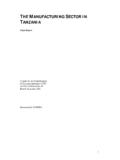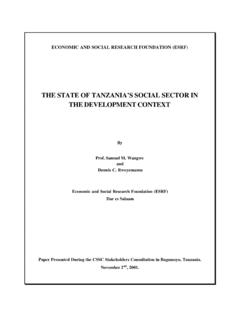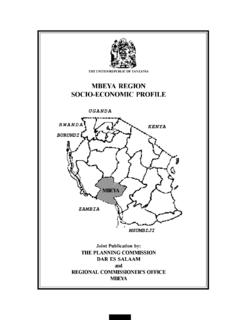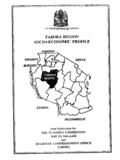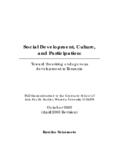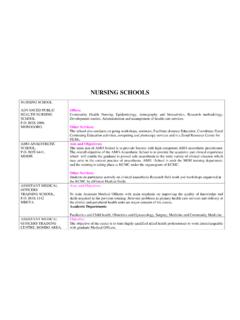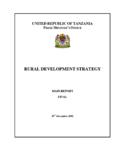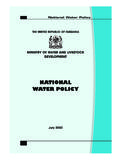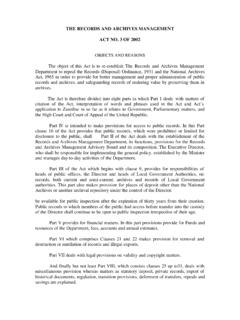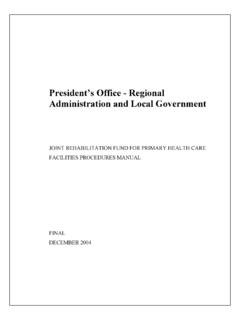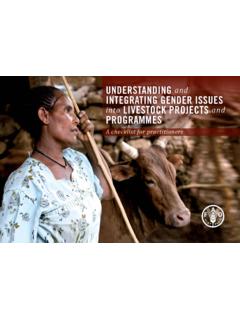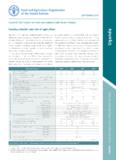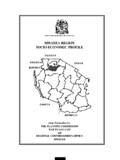Transcription of MTWARA REGION SOCIO-ECONOMIC PROFILE - …
1 THE UNITED REPUBLIC OF TANZANIA. MTWARA REGION . SOCIO-ECONOMIC PROFILE . uganda . RWANDA KENYA. BURUNDI. MTWARA . REGION . ZAMBIA. MSUMBIJI. Joint Publication by: THE PLANNING COMMISSION. DAR ES SALAAM. and REGIONAL COMMISSIONER'S OFFICE. MTWARA . TABLE OF CONTENTS. Page SECTION I. LAND, PEOPLE AND CLIMATE. Geographical Location:.. 1. Land Area:.. 1. Administrative Units:.. 1. Ethnicity:.. 4. Population Size, Growth and Distribution:.. 4. Population sex, households and Age Groups:.. 15. Urban/Rural Population Distribution:.. 24. Migration and 27. Climate and Soils.
2 30. Topography and Drainage:.. 31. Agro-Ecological Zones:.. 31. SECTION II. REGIONAL ECONOMY. INTRODUCTION:.. 34. REGIONAL GDP AND PER CAPITA GDP: .. 35. PRODUCTIVE 43. 2. Agriculture .. 43. Livestock:.. 61. Forestry:.. 65. Fishery:.. 69. Wildlife:.. 73. Beekeeping:.. 74. Mining:.. 77. Industries:.. 78. i SECTION III. SOCIAL SERVICES. EDUCATION: .. 79. Pre-School Education:.. 79. Primary School Education:.. 81. Primary School Dropouts:.. 87. Primary School Teachers:.. 91. Primary education Infrastructure:.. 92. Comparative Status of Primary Education in MTWARA REGION .
3 95. Special Primary Schools .. 98. Adult 99. Secondary School Education:.. 105. 112. 112. Morbidity and 113. Health Facilities .. 118. Child Immunization:.. 125. Child Nutrition:.. 127. Infant and Under five Mortality:.. 131. Maternal Mortality:.. 135. AIDS: .. 140. Life Expectancy .. 142. Other Health Issues .. 143. WATER SUPPLY .. 146. 146. Rural Water 146. Urban Water Supplies .. 148. Sanitation .. 151. ii SECTION IV. economic INFRASTRUCTURE. 154. Roads .. 154. ROAD NETWORK - MTWARA 156. Air 159. Marine 163. Telecommunication 164. 164. Electricity:.. 164.
4 167. Other forms of 167. Land development .. 167. SECTION V. OTHER DEVELOPMENT ISSUES. W OMEN IN DEVELOPMENT :.. 169. Women at Household Level:.. 169. Women leadership at above household level: .. 170. Gender Issues and the Alleviation of Poverty:.. 172. Environmental Conservation:.. 175. Tourism:.. 178. SECTION VI. POTENTIAL INVESTMENT AREAS. Agriculture:.. 179. Livestock:.. 180. Forestry:.. 182. Beekeeping:.. 182. Mining:.. 182. Industrial Development:.. 183. Transport:.. 183. Energy:.. 184. Health:.. 185. iii Education:.. 186. Water Supply:.. 186. Environmental Protection.
5 187. Women Development:.. 188. Tourism and Wildlife:.. 188. ANNEX A. MTWARA REGION in a 189. ANNEX B. MTWARA /Mikindani District Summary (1996) .. 201. ANNEX C. MTWARA Rural District Summary (1996) .. 206. ANNEX D. Newala District Summary .. 212. ANNEX E. Masasi District Summary .. 218. ANNEX H. GENERAL INFORMATION ABOUT TANZANIA .. 224. Area Of Mainland .. 224. Tanzania Mainland Area By regions (Sq Km).. 224. 225. Life Expectancy For Tanzania - By regions , 1967, 1978, 1988, 1996: .. 225. Land 226. Arable Land:.. 226. Lakes .. 226. Mountain Summits (Metres Above Sea Level).
6 226. Climate .. 227. 227. Social 228. Health Facilities .. 228. National 229. iv FOREWORD. 1. As we approach the 21st Century the problems facing rural areas in developing countries like Tanzania are numerous and formidable. Social and economic services are deteriorating and proving to be unsustainable; school enrollment rates are declining; food situation is precarious; infant and maternal mortality rates continue to be high; unemployment is on the rise triggering off mass migration of youth from the rural areas into already overcrowded urban centres; in MTWARA REGION , for example, land pressure is escalating and deforestation is going on at an alarming rate.
7 2. This situation has arisen because of many factors including ill - prepared rural development programmes and weak monitoring and supervision of the implementation of development programmes and sectoral strategies. The observed shortcomings in the policy formulation, project identification, design, and implementation in the developing countries is in turn attributed to lack of reliable and adequate data and information on the rural development process. 3. The publication of Regional SOCIO-ECONOMIC Profiles series by the Planning Commission in collaboration with Regional Commissioner's offices should be viewed as a fruitful attempt towards finding solutions to the existing problem of data and information gap.
8 4. The Regional PROFILE series cover a wide range of data and information on geography, population, social economic parameters, social services, economic infrastructure and productive sectors. The publications so far have proved to be v of high demand and a vital source of information to many policy makers, planners, researchers, donors and functional managers. The Planning Commission has found it a worthwhile effort to extend the exercise to cover even more regions . Readers are invited to make suggestions and constructive criticisms which can assist in improving the quality and effectiveness of future Profiles.
9 5. I would like to take this opportunity to acknowledge with thanks once again the financial support of the Royal Norwegian Embassy which facilitated the preparation of the MTWARA REGION SOCIO-ECONOMIC PROFILE . I would also like to thank both the Planning Commission and MTWARA Regional Planning Staff who put a lot of effort into ensuring the successful completion of this task. Nassoro W. Malocho (MP). MINISTER OF STATE. PLANNING AND PARASTATAL SECTOR REFORM. December, 1997. vi SECTION I. LAND, PEOPLE AND CLIMATE. Geographical Location: MTWARA REGION is one of 20 regions of Tanzania Mainland.
10 It is the southernmost REGION . It lies between longitudes 38o and 40o 30" east of Greenwich. It is also situated between latitudes 10o 05" and 11o 25" south of the Equator. It borders Lindi REGION to the north, the Indian Ocean to the east and separated by the Ruvuma river from Mozambique in the south. To the west it borders Ruvuma REGION . Land Area: The REGION occupies 16,720 sq. kms or of Tanzania Mainland land area of 885,987 sq. kms. It is the second smallest REGION after Kilimanjaro. The REGION is divided between districts as in Table I - 1. Administrative Units: MTWARA REGION is administratively subdivided into 5 districts, 21.
